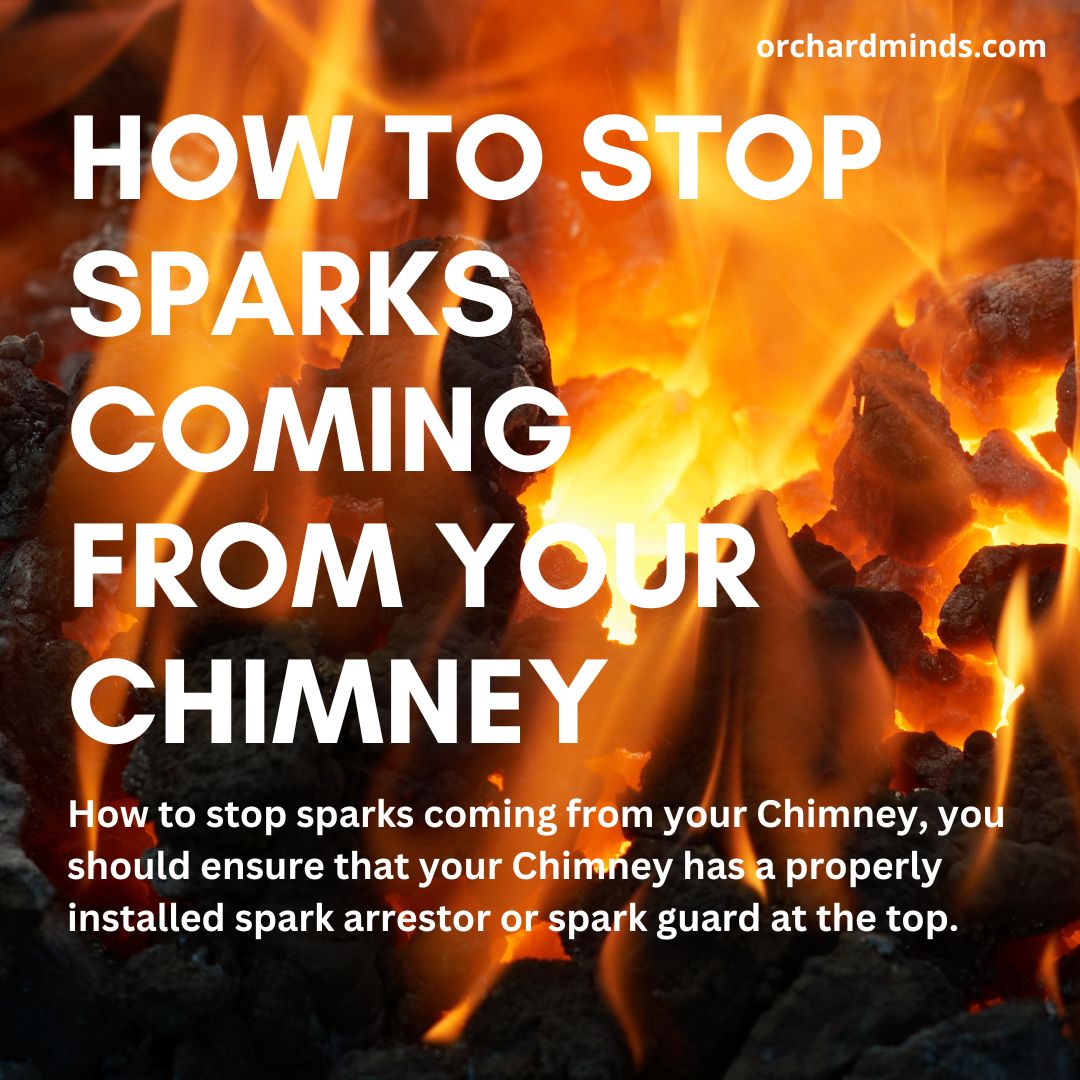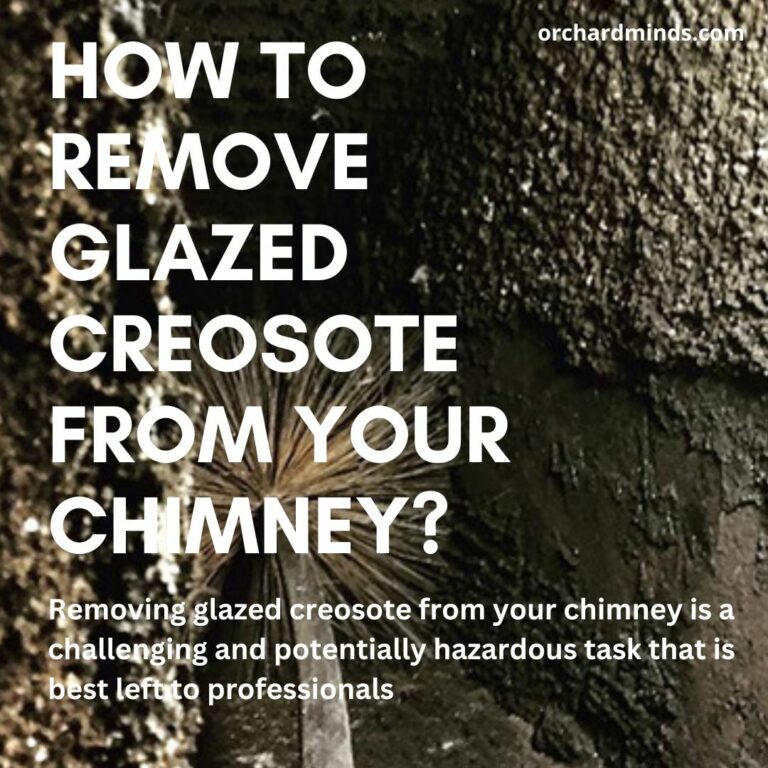How to stop sparks coming from your Chimney, you should ensure that your Chimney has a properly installed spark arrestor or spark guard at the top. A spark arrestor is a mesh screen or metal cap designed to prevent sparks, embers, and debris from escaping the Chimney and potentially causing a fire.
Regular chimney maintenance, including cleaning out creosote buildup and inspecting for any obstructions, is also essential to minimize the risk of sparks. Additionally, always use seasoned and dry wood in your fireplace or wood stove, as wet or unseasoned wood can create more sparks and embers.
What Causes Small Sparks Coming Out of Chimneys?
Tiny sparks coming out of chimneys are typically caused by burning wood or other combustibles in the fireplace or stove. These sparks occur when hot embers or debris are carried up the Chimney with the rising smoke and come into contact with the outside air, igniting and creating tiny sparks.
Creosote Buildup
Creosote buildup is a common issue in chimneys that use wood as a fuel source. Creosote is a highly flammable substance that can accumulate on the interior walls of the Chimney over time. If left unaddressed, it can pose a severe fire hazard. Hiring a chimney and fireplace expert is highly recommended for regular inspections and cleanings. They have the tools and knowledge to safely remove creosote and ensure your Chimney remains safe for use.
Animal Nesting in Chimney
Animals, such as birds or squirrels, often seek shelter in chimneys, creating nests that can block the chimney flue. This can lead to poor ventilation, smoke backflow, and even carbon monoxide buildup in your home. Chimney professionals are skilled in safely removing animal nests, installing chimney caps or screens to prevent future intrusions, and ensuring your Chimney is free from obstructions.
Chimney Blocked with Debris
Chimney blockages due to debris, leaves, or other foreign objects can impede proper airflow and ventilation, increasing the risk of smoke or even toxic gases entering your living space. It’s crucial to have a chimney expert assess and clear any blockages, as they have the necessary equipment and expertise to do so safely. Regular chimney inspections can help identify and prevent these issues.
Do You Need to Hire a Chimney and fireplace Expert?
Hiring a chimney and fireplace expert is advisable in several situations:
- Regular Maintenance: Regular inspections and cleanings by experts help prevent creosote buildup, blockages, and other potential issues. This maintenance ensures your Chimney and fireplace operate safely and efficiently.
- Safety Concerns: If you suspect safety issues, such as a damaged chimney liner or cracks in the chimney structure, it’s crucial to consult a professional. They can identify and address these concerns, reducing the risk of accidents or fires.
- Blockages or Animal Intrusions: If your Chimney is blocked by debris or animals have nested inside, a chimney expert can safely remove obstructions and install preventive measures, like chimney caps, to keep it clear in the future.
- Installation or Upgrades: When installing a new fireplace or making upgrades, professionals ensure proper venting, compliance with building codes, and safe installation to prevent hazards.
- Repairs: For chimney and fireplace repairs, it’s best to rely on experts who understand the intricacies of these systems to ensure they function correctly and safely.
Is it Normal for Sparks to Come Out of a Chimney?
It is not entirely unusual for tiny sparks or embers to occasionally come out of a chimney while using a fireplace or wood-burning stove. However, it’s essential to differentiate between occasional, minor sparks and excessive or continuous sparks. Occasional sparks can result from burning wood or other combustibles, and they are usually relatively small and harmless.
Excessive sparks or continuous sparks, on the other hand, can be a sign of a problem. This could indicate issues such as an excessive buildup of creosote in the Chimney, improper wood-burning practices, or a blockage that’s causing poor ventilation. Suppose you notice a significant increase in sparks or embers. In that case, it’s wise to have your Chimney inspected by a professional to ensure there are no safety concerns or issues that need addressing.
How Do You Detect Sparks from Chimneys?
To detect sparks from chimneys, visually inspect the area around the Chimney during use for any tiny glowing embers or sparks that may be escaping. Additionally, listen for crackling sounds, which can indicate the presence of sparks.
Visual External Chimney Inspection
Look for visible sparks or embers escaping from the Chimney’s top while the fireplace or stove is in use. This is easiest to spot during nighttime operations when sparks are more visible.
Visual Internal Chimney Inspection
Check inside the fireplace or stove for any sparks or embers that may be escaping through cracks, gaps, or damaged components in the firebox or flue.
Listen for Sounds
Sometimes, you can detect sparks by listening to the crackling sound they make when they come into contact with the Chimney or other surfaces. However, this method may not always be reliable, especially if the sparks are small or infrequent.
What are the First Chimney Fire Signs?
The first signs of a chimney fire include a loud cracking or popping noise from the Chimney and dense, dark smoke exiting the Chimney’s top. Inside, you may notice an intense, roaring sound and flames visible through the stovepipe or flue.
Flames or Sparks Coming from the Chimney
Seeing flames or sparks coming from your Chimney is a clear indicator of a chimney fire. These flames can be visible through the Chimney’s top or even from within the fireplace or stove. This is a serious and dangerous situation that requires immediate action to prevent further escalation.
Smoke Coming from the Chimney
Excessive smoke coming from the Chimney, mainly if it is thick and dark, can also signal a chimney fire. Smoke during a chimney fire is often dense and may have a strong, acrid smell. It is essential to take immediate safety measures if you observe this sign.
Loud Cracking, Popping, or Roaring Noise
Chimney fires are accompanied by distinctive sounds, such as loud cracking, popping, or roaring noises. These noises are caused by the intense heat and flames inside the Chimney, which can damage the Chimney’s structure and pose a significant fire hazard. If you hear these sounds, it’s crucial to take immediate action by calling emergency services and vacating your home safely.
What to Do If You Have a Chimney Fire?
- Call the Fire Department: Immediately dial 911 or the emergency services number in your area to report the chimney fire. Do not attempt to fight the fire on your own.
- Evacuate Safely: Ensure that everyone in your household is safely evacuated from the building, including pets. Do not delay; chimney fires can escalate rapidly.
- Close Fireplace Dampers and Vents: Close the dampers on your fireplace or stove to reduce the air supply to the fire. This can help slow down the fire’s progression.
- Monitor the Exterior: Keep an eye on the exterior of your home to ensure the fire has not spread to the roof or nearby structures.
- Wait for Professionals: Allow trained firefighters to handle the situation. Do not re-enter your home until they confirm it is safe to do so. Chimney fires can cause hidden structural damage, so professional assessment is essential.
How to Stop Embers Coming Out of Chimneys?
Install Chimney Spark Arrestors
Installing a spark arrestor or spark guard on your Chimney’s top is an effective way to prevent sparks and embers from escaping and potentially starting a fire. These devices feature mesh screens that allow smoke to vent while trapping sparks and debris.
Burn Seasoned Firewood
Using correctly seasoned firewood with low moisture content reduces the formation of creosote, a flammable substance that can lead to chimney fires. Seasoned wood burns more cleanly and efficiently, minimizing the risk of sparks and creosote buildup.
Keep Your Roof and Rain Gutters Clean
Regularly clean your roof and rain gutters to remove leaves, twigs, and debris that can accumulate. Debris on your roof or in gutters can become fuel for chimney fires if ignited by sparks or embers.
Annual Chimney Cleaning
Schedule an annual chimney cleaning and inspection by a certified chimney sweep. They will remove creosote buildup, check for blockages, and ensure your Chimney is in good condition. This proactive measure helps maintain safety and efficiency in your fireplace or stove.
FAQS about How to stop sparks coming from your Chimney
What causes sparks to come out of my Chimney?
Sparks typically result from burning wood or other combustibles in your fireplace or stove. They can occur when hot embers or debris are carried up the Chimney and come into contact with outside air.
How can I prevent sparks from coming out of my Chimney?
To prevent sparks, install a spark arrestor or spark guard on your Chimney’s top. Additionally, burn properly seasoned firewood, keep your roof and gutters clean, and schedule annual chimney cleaning and inspections.
Are sparks from the Chimney dangerous?
Yes, sparks can be dangerous as they pose a fire hazard. Uncontrolled sparks can ignite nearby flammable materials, potentially leading to a chimney or house fire.
What is a spark arrestor or spark guard?
A spark arrestor is a device, often a mesh screen or metal cap, that is installed at the top of your Chimney. It traps sparks and embers while allowing smoke to escape, reducing the risk of sparks escaping.
How often should I clean my Chimney to prevent sparks?
It’s recommended to have your Chimney cleaned and inspected annually by a certified chimney sweep. Regular cleaning helps remove creosote buildup, a significant spark contributor.
What type of wood should I burn to minimize sparks?
Burn seasoned firewood with low moisture content. This type of wood burns more cleanly and generates fewer sparks and embers compared to wet or unseasoned wood.
What is a spark arrestor or spark guard?
A spark arrestor is a device, often a mesh screen or metal cap, that is installed at the top of your Chimney. It traps sparks and embers while allowing smoke to escape, reducing the risk of sparks escaping.
How often should I clean my Chimney to prevent sparks?
It’s recommended to have your Chimney cleaned and inspected annually by a certified chimney sweep. Regular cleaning helps remove creosote buildup, a significant spark contributor.
What type of wood should I burn to minimize sparks?
Burn seasoned firewood with low moisture content. This type of wood burns more cleanly and generates fewer sparks and embers compared to wet or unseasoned wood.
Can I stop sparks on my own, or should I hire a professional?
While you can take some preventive measures, like using seasoned firewood, hiring a professional chimney sweep is essential for proper spark prevention, chimney cleaning, and maintenance.
What should I do if I notice excessive sparks coming from my Chimney?
If you see a significant increase in sparks, it’s essential to have your Chimney inspected by a professional. This may indicate issues like creosote buildup or blockages that need addressing to ensure safety.
Is there a risk of sparks even with a spark arrestor in place?
While spark arrestors are effective, they may not eliminate sparks. It’s crucial to use best practices in wood burning and chimney maintenance in conjunction with a spark arrestor for maximum safety.
Can I use my fireplace or wood-burning stove during windy conditions without sparking concerns?
It’s best to exercise caution during windy conditions, as strong winds can potentially blow sparks or embers out of the Chimney. Use a spark arrestor and be attentive to the fireplace or stove during such conditions.




Leave a Comment